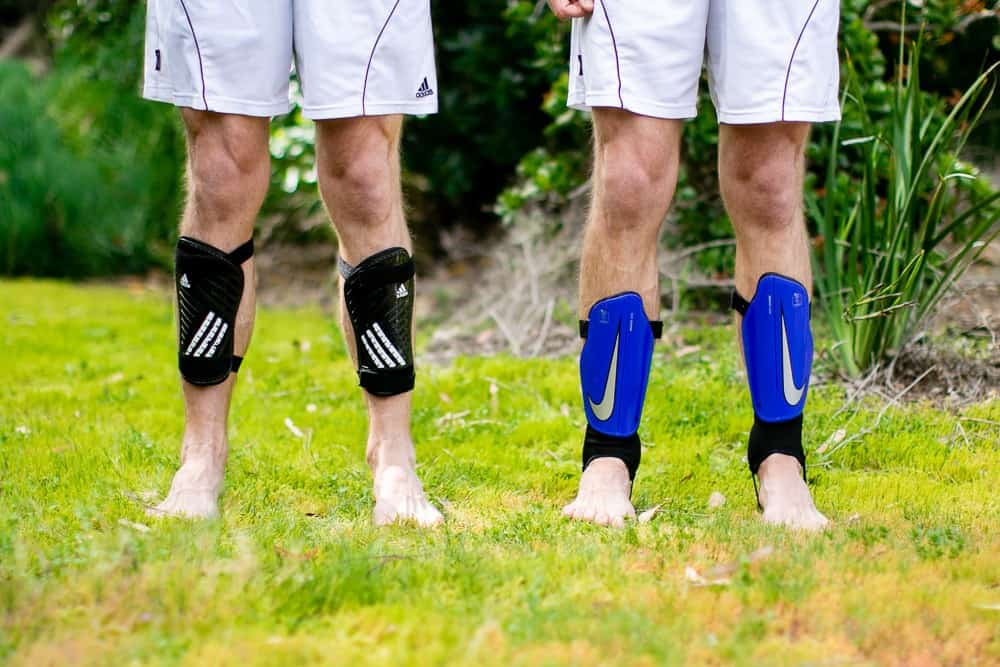From dazzling footwork to powerful headers, the beautiful game of soccer demands agility, skill, and…protection. Among the essential protective gear donned by players, shin guards occupy a prominent place. But have you ever wondered why do soccer players wear shin guards? Is it just a relic of the past, or does it serve a crucial purpose on the modern pitch?
Also Read: https://megadportevents.com/why-do-soccer-players-fake-injuries/
Why do Soccer players wear Shin Guards?
The answer lies in understanding the vulnerability of the lower leg, specifically the tibia bone (shinbone). This area lacks significant muscle protection, making it susceptible to severe pain and injuries from kicks, tackles, and impacts with the ball. Wearing shin guards mitigates these risks by absorbing and dispersing the force of such impacts, significantly reducing the chances of:
- Fractures: The hard plastic shell of shin guards deflects and distributes the force of a blow, preventing cracks or breaks in the tibia bone.
- Contusions: The padding within the guards absorbs impact energy, minimizing pain and bruising caused by kicks or collisions.
- Cuts and abrasions: The hard shell acts as a barrier, protecting the skin from scrapes and cuts caused by sliding tackles or falls.
Therefore, wearing shin guards is not just an optional practice; it’s an essential safety measure for players at all levels, from recreational kickabouts to professional matches. Mandatory in most organized leagues, shin guards are a vital line of defence against potentially debilitating injuries.

Choosing the Right Fit: Comfort and Protection Go Hand-in-Hand
While the importance of wearing shin guards is undeniable, ensuring optimal comfort and protection requires choosing the right fit. Here are some key factors to consider:
- Size: Shin guards should fit snugly without restricting movement. Opt for guards that cover the entire tibia and extend slightly above the ankle bone.
- Material: Opt for hard plastic shells for maximum protection, but consider comfort-enhancing features like shock-absorbing padding or breathable linings.
- Closure system: Lace-up, Velcro, or slip-on options are available. Choose one that offers a secure and comfortable fit without slipping during play.
Remember, wearing shin guards that don’t fit properly can be counterproductive. Ill-fitting guards can cause discomfort, restrict movement, and even increase the risk of injuries. So, invest in a good quality pair that prioritizes protection and comfort.
Also Read: https://megadportevents.com/why-do-soccer-players-exchange-jerseys/
Shin Guard Materials: A Breakdown
Outer Shells:
- Polypropylene: Lightweight, durable, and affordable.
- High-density polyethylene (HDPE): Offers more impact resistance than polypropylene.
- Fiberglass: Lightweight and strong, but can be uncomfortable.
- Carbon fibre: A top-of-the-line option that offers exceptional rigidity and protection but is more expensive.
Padding:
- EVA foam: Common choice, providing good shock absorption and comfort.
- Poron XRD: Advanced material offering high-impact absorption and energy deflection.
- Gel: Additional comfort and impact management, often used with other materials.
Remember, material combinations and features can vary within each category. Choose based on your comfort, budget, and desired level of protection.

Finding Your Fit: Exploring Different Shin Guard Options
Beyond material variations, shin guards come in different forms to cater to player preferences and playing styles:
- Slip-in shin guards: Lightweight and easy to wear, these slip directly under socks. They offer essential protection but might be better for aggressive play.
- Ankle shin guards: Offer more coverage and protection, extending to the ankle bone. They often come with straps or sleeves for a secure fit.
- Compression shin guards: Combine protection with compression benefits, aiding muscle recovery and blood flow. These can be tight-fitting and might only suit some.
- Shin sleeves: A hybrid option, offering some impact protection with a focus on comfort and compression. Popular among goalkeepers and players seeking flexibility.
Consider your playing style, comfort level, and desired protection level when choosing the right type of shin guard. Experiment with different options to find the perfect fit that allows you to perform at your best while staying safe on the pitch.
Also Read: https://megadportevents.com/how-high-can-soccer-players-jump/
Beyond the Basic Protection: Benefits of Advanced Shin Guards
The evolution of shin guards goes beyond essential protection. Modern advancements offer additional features and benefits:
- Anatomical design: Some guards are contoured to the leg’s natural shape, providing a more comfortable and secure fit.
- Impact-absorbing materials: Innovative materials like EVA foam offer enhanced shock absorption for improved protection.
- Moisture-wicking fabrics: Breathable linings help regulate temperature and prevent sweat build-up, contributing to player comfort.
While these advanced features might come at a higher price tag, their enhanced protection and comfort can be worthwhile for serious players seeking a competitive edge.
Also Read: https://megadportevents.com/can-you-play-soccer-with-contact-lenses/
Looking Beyond the Surface: The Mental Benefits of Shin Guards
The psychological impact of wearing shin guards is often overlooked. Knowing you’re adequately protected allows players to:
- Play with more confidence: Reduced fear of injury allows players to tackle challenges confidently, potentially improving their performance.
- Focus on the game: By minimizing injury concerns, players can concentrate on their skills and tactics, enhancing their overall gameplay.
- Set a positive example: Young players often emulate the behaviour of professionals. Promoting the use of shin guards fosters a culture of safety and responsibility on the field.
These intangible benefits highlight the holistic impact of wearing shin guards and their contribution to a positive and enjoyable playing experience.

Mandatory Protection on the Pro Pitch: The Shin Guard Rule
In the professional arena, wearing shin guards transcends recommendation and becomes mandatory. Most major leagues, including FIFA, enforce strict regulations demanding players wear shin guards that meet specific safety standards. These regulations often specify the minimum coverage area, material composition, and testing criteria to ensure adequate protection. Referees are empowered to penalize players without proper shin guards, highlighting the seriousness of this safety measure. So, while individual preferences might exist, in professional soccer, wearing shin guards is not optional; it’s a non-negotiable element of ensuring player safety and maintaining fair competition.
Beyond the Pitch: A Legacy of Protection
From amateur leagues to the World Cup stage, shin guards have become integral to the soccer landscape. Their evolution reflects the sport’s commitment to player safety and well-being. By understanding “why do Soccer Players wear shin guards”, players at all levels can make informed choices, prioritize protection, and enjoy the beautiful game to its fullest potential. So, the next time you step onto the pitch, remember that those shin guards aren’t just an accessory; they’re a shield, a confidence booster, and a testament to the sport’s commitment to its players.





